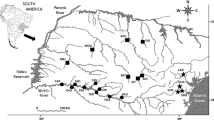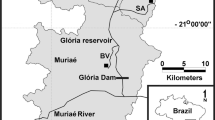Abstract
Reservoir construction and the introduction of nonnative species are major anthropogenic drivers of biotic change in freshwater ecosystems. To understand the influence of these drivers, we quantified the degree to which fish faunas have either homogenized or differentiated at multiple spatial scales across the Great Plains—Rocky Mountain continuum (Wyoming, USA), given that homogenization processes are scale-dependent. Homogenization was most prevalent at the largest scale, with an average increase in similarity of 6.8% among river basins. At an intermediate scale, sub-basins with reservoirs had homogenized faunas in comparison to sub-basins without reservoirs, which were more differentiated. Differentiation was dominant at the smallest scale with a 7.8% average decrease in similarity among individual sampling sites. Reservoirs had only localized homogenization impacts along stream systems, and homogenization was greater for streams connected to large reservoirs. Large-sized streams appeared to trend towards homogenization, whereas small and medium streams trended towards differentiation. Reservoirs altered fish faunas from historical conditions, but did not result in cross-stream homogenization because of the idiosyncratic nature of reservoir introductions that reflect environmental gradients and socio-economic factors. Our results provide insight into how spatial scale, reservoirs, and nonnative species interact to influence the degree of homogenization and differentiation.





Similar content being viewed by others
References
Alofs, K. M., D. A. Jackson & N. P. Lester, 2014. Ontario freshwater fishes demonstrate differing range-boundary shifts in a warming climate. Diversity and Distributions 20: 123–136.
Anderson, M. J., 2006. Distance-based tests for homogeneity of multivariate dispersion. Biometrics 62: 245–253.
Bae, M., C. A. Murphy & E. García-Berthou, 2018. Temperature and hydrologic alteration predict the spread of invasive largemouth bass (Micropterus salmoides). Science of the Total Environment 639: 58–66.
Barrineau, C. E., E. A. Bear & A. C. Senecal, 2010. Current distribution of rare fishes in eastern Wyoming prairie streams. The Prairie Naturalist 42: 80–88.
Baxter, G. T. & J. R. Simon, 1970. Wyoming Fishes. Wyoming Game and Fish Department, Cheyenne, Wyoming, USA.
Baxter, G. T. & M. D. Stone, 1995. Fishes of Wyoming. Wyoming Game and Fish Department, Cheyenne, Wyoming, USA.
Buckwalter, J. D., E. A. Frimpong, P. L. Angermeier & J. N. Barney, 2018. Seventy years of stream-fish collections reveal invasions and native range contractions in an Appalachian (USA) watershed. Diversity and Distributions 24: 219–232.
Buijse, A. D., H. Coops, M. Staras, L. H. Jans, G. J. Van Geest, R. E. Grifts, B. W. Ibelings, W. Oosterberg & F. C. J. M. Roozen, 2002. Restoration strategies for river floodplains along large lowland rivers in Europe. Freshwater Biology 47: 889–907.
Buisson, L. & G. Grenouillet, 2009. Contrasted impacts of climate change on stream fish assemblages along an environmental gradient. Diversity and Distributions 15: 613–626.
Carpenter, S. R., E. H. Stanley & M. Jake Vander Zanden, 2011. State of the world’s freshwater ecosystems: physical, chemical, and biological changes. Annual Review of Environment and Resources 36: 75–99.
Clavero, M. & E. García-Berthou, 2006. Homogenization dynamics and introduction routes of invasive freshwater fish in the Iberian Peninsula. Ecological Applications 16: 2313–2324.
Clavero, M. & V. Hermoso, 2011. Reservoirs promote the taxonomic homogenization of fish communities within river basins. Biodiversity and Conservation 20: 41–57.
Cooper, A. R., D. M. Infante, W. M. Daniel, K. E. Wehrly, L. Wang & T. O. Brenden, 2017. Assessment of dam effects on streams and fish assemblages of the conterminous USA. Science of the Total Environment 586: 879–889.
Craig, L. S., J. D. Olden, A. H. Arthington, S. Entrekin, C. P. Hawkins, J. J. Kelly, T. A. Kennedy, B. M. Maitland, E. J. Rosi, A. H. Roy, D. L. Strayer, J. L. Tank, A. O. West & M. S. Wooten, 2017. Meeting the challenge of interacting threats in freshwater ecosystems: A call to scientists and managers. Elementa: Science of the Anthropocene 5: 1–15.
Evermann, B. W., & U. O. Cox, 1896. A report upon the fishes of the Missouri River basin. Report to the U.S. commission of fish and fisheries 20: 325-429.
Falke, J. A. & K. B. Gido, 2006. Spatial effects of reservoirs on fish assemblages in Great Plains streams in Kansas, USA. River Research and Applications 22: 55–68.
Gibson-Reinemer, D. K., F. J. Rahel, S. E. Albeke & R. M. Fitzpatrick, 2017. Natural and anthropogenic barriers to climate tracking in river fishes along a mountain-plains transition zone. Diversity and Distributions 23: 761–770.
Gido, K. B., J. G. Schaefer & J. Pigg, 2004. Patterns of fish invasions in the Great Plains of North America. Biological Conservation 118: 121–131.
Gido, K. B., J. G. Schaefer & J. A. Falke, 2009. Convergence of fish communities from the littoral zone of reservoirs. Freshwater Biology 54: 1163–1177.
Gido, K. B., W. K. Dodds & M. E. Eberle, 2010. Retrospective analysis of fish community change during a half-century of landuse and streamflow changes. Journal of North American Benthological Society 29: 970–987.
Gozlan, R. E., J. R. Britton, I. Cowx & G. H. Copp, 2010. Current knowledge on non-native freshwater fish introductions. Journal of Fish Biology 76: 751–786.
Hermoso, V., M. Clavero & M. J. Kennard, 2012. Determinants of fine-scale homogenization and differentiation of native freshwater fish faunas in a Mediterranean basin: implications for conservation. Diversity and Distributions 18: 236–247.
Kuczynski, L., P. Legendre & G. Grenouillet, 2018. Concomitant impacts of climate change, fragmentation, and non-native species have led to reorganization of fish communities since the 1980s. Global Ecology and Biogeography 27: 213–222.
Lambdon, P. W., F. Lloret & P. E. Hulme, 2008. Do non-native species invasions lead to biotic homogenization at small scales? The similarity and functional diversity of habitats compared for alien and native components of Mediterranean floras. Diversity and Distributions 14: 774–785.
Leprieur, F., O. Beauchard, S. Blanchet, T. Oberdorff & S. Brosse, 2008. Fish invasions in the World’s river systems: when natural processes are blurred by human activities. PLoS Biology 6: 404–409.
Lipsey, T. S. B., W. A. Hubert & F. J. Rahel, 2005. Relationships of elevation, channel slope, and stream width to occurrences of native fishes at the Great Plains-Rocky Mountain interface. Journal of Freshwater Ecology 20: 695–705.
Marchetti, M. P., T. Light, J. Feliciano, T. Armstrong, Z. Hogan, J. Viers & P. B. Moyle, 2001. Homogenization of California’s fish fauna through abiotic change. In Lockwood, J. L. & M. L. McKinney (eds), Biotic Homogenization. Kluwer Academic Press, New York: 259–278.
Marchetti, M. P., J. L. Lockwood & T. Light, 2006. Effects of urbanization on California’s fish diversity: differentiation, homogenization, and the influence of spatial scale. Biological Conservation 127: 310–318.
Mims, M. C. & J. D. Olden, 2013. Fish assemblages respond to altered flow regimes via ecological filtering of life history strategies. Freshwater Biology 58: 50–62.
Olden, J. D. & N. LeRoy Poff, 2003. Toward a mechanistic understanding and prediction of biotic homogenization. The American Naturalist 162: 442–460.
Olden, J. D. & T. P. Rooney, 2006. On defining and quantifying biotic homogenization. Global Ecology and Biogeography 15: 113–120.
Olden, J. D., N. L. Poff & M. L. McKinney, 2006. Forecasting faunal and floral homogenization associated with human population geography in North America. Biological Conservation 127: 261–271.
Olden, J. D., M. J. Kennard & B. J. Pusey, 2008. Species invasions and the changing biogeography of Australian freshwater fishes. Global Ecology and Biogeography 17: 25–37.
Patton, T. M., F. J. Rahel & W. A. Patton, 1998. Using historical data to assess changes in Wyoming’s fish fauna. Conservation Biology 12: 1120–1128.
Pease, A. A. & C. P. Paukert, 2014. Potential impacts of climate change on growth and prey consumption of stream-dwelling smallmouth bass in the central United States. Ecology of Freshwater Fish 23: 336–346.
Perkin, J. S., K. B. Gido, J. A. Falke, K. D. Fausch, H. Crockett, E. R. Johnson & J. Sanderson, 2017. Groundwater declines are linked to changes in Great Plains stream fish assemblages. Proceedings of the National Academy of Sciences 114: 7373–7378.
Poff, N. L., J. D. Olden, D. M. Merritt & D. M. Pepin, 2007. Homogenization of regional river dynamics by dams and global biodiversity implications. Proceedings of the National Academy of Sciences 104: 5732–5737.
Pool, T. K., J. D. Olden, J. B. Whittier & C. P. Paukert, 2010. Environmental drivers of fish functional diversity and composition in the Lower Colorado River basin. Canadian Journal of Fisheries and Quatic Sciences 67: 1791–1807.
Quist, M. C., W. A. Hubert & F. J. Rahel, 2004a. Relations among habitat characteristics, exotic species, and turbid-river cyprinids in the Missouri River drainage of Wyoming. Transactions of the American Fisheries Society 133: 727–742.
Quist, M. C., W. A. Hubert & F. J. Rahel, 2004b. Elevation and stream-size thresholds affect distributions of native and exotic warmwater fishes in Wyoming. Journal of Freshwater Ecology 19: 227–236.
R Development Core Team, 2017. R: a language and environment for statistical computing. R Foundation for Statistical Computing, Vienna. http://www.R-project.org
Rahel, F. J., 2000. Homogenization of fish faunas across the United States. Science 288: 854–856.
Rahel, F. J., 2007. Biogeographic barriers, connectivity, and homogenization of freshwater faunas: it’s a small world after all. Freshwater Biology 52: 696–710.
Rahel, F. J., 2010. Homogenization, differentiation, and the widespread alteration of fish faunas. American Fisheries Society Symposium 73: 311–326.
Rahel, F. J. & W. A. Hubert, 1991. Fish assemblages and habitat gradients in a Rocky Mountain-Great Plains stream: biotic zonation and additive patterns of community change. Transactions of the American Fisheries Society 120: 319–332.
Rahel, F. J. & M. A. Smith, 2018. Pathways of unauthorized fish introductions and types of management responses. Hydrobiologia 817: 41–56.
Richardson, L. E., N. A. J. Graham, M. S. Pratchett, J. G. Eurich & A. S. Hoey, 2018. Mass coral-bleaching causes biotic homogenization of reef fish assemblages. Global Change Biology 24: 3117–3129.
Simon, J. R., 1946. Wyoming Fishes. Wyoming Game and Fish Department, Cheyenne, Wyoming, USA.
Stewart, D. R., A. W. Walters & F. J. Rahel, 2016. Landscape-scale determinants of native and non-native Great Plains fish distributions. Diversity and Distributions 22: 225–238.
Taylor, E. B., 2004. An analysis of homogenization and differentiation of Canadian freshwater fish faunas with an emphasis on British Columbia. Canadian Journal of Fisheries and Aquatic Sciences 61: 68–79.
Toussaint, A., O. Beauchard, T. Oberdorff, S. Brosse & S. Villéger, 2016. Worldwide freshwater fish homogenization is driven by a few widespread non-native species. Biological Invasions 18: 1295–1304.
Villéger, S., S. Blanchet, O. Beauchard, T. Oberdorff & S. Brosse, 2011. Homogenization patterns of the world’s freshwater fish faunas. Proceedings of the National Academy of Science 108: 18003–18008.
Villéger, S., S. Blanchet, O. Beauchard, T. Oberdorff & S. Brosse, 2015. From current distinctiveness to future homogenization of the world’s freshwater fish faunas. Diversity and Distributions 21: 223–235.
Vitule, J. R. S., F. Skóra & V. Abilhoa, 2012. Homogenization of freshwater fish faunas after the elimination of a natural barrierby a dam in Neotropics. Diversity and Distributions 18: 111–120.
Walters, A. W., C. P. Mandeville & F. J. Rahel, 2018. The interaction of exposure and warming tolerance determines fish species vulnerability to warming stream temperatures. Biology Letters 14: 20180342.
Zuur, A. F., E. N. Ieno & C. S. Elphick, 2010. A protocol for data exploration to avoid common statistical problems. Methods in Ecology and Evolution 1: 3–14.
Acknowledgements
Funding for this project was provided by the Biodiversity Institute at the University of Wyoming. We would like to thank two anonymous reviewers who provided constructive comments that helped improve the quality of this manuscript.
Author information
Authors and Affiliations
Corresponding author
Additional information
Publisher's Note
Springer Nature remains neutral with regard to jurisdictional claims in published maps and institutional affiliations.
Guest editors: André A. Padial, Julian D. Olden & Jean R. S. Vitule / The Aquatic Homogenocene
Electronic supplementary material
Below is the link to the electronic supplementary material.
Rights and permissions
About this article
Cite this article
Kirk, M.A., Maitland, B.M. & Rahel, F.J. Spatial scale, reservoirs and nonnative species influence the homogenization and differentiation of Great Plains—Rocky Mountain fish faunas. Hydrobiologia 847, 3743–3757 (2020). https://doi.org/10.1007/s10750-019-04129-5
Received:
Revised:
Accepted:
Published:
Issue Date:
DOI: https://doi.org/10.1007/s10750-019-04129-5




